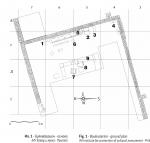Summary (English)
Within the frames of a wider field campaign in 2014-2015 at the archaeological site and ancient town of Stibera, near modern-day Chepigovo, the “Temple of Tyche – northern plateau” sector was investigated for the first time. On this terrace are found the remains of a monumental building, partially uncovered in the 20×20 m excavated area, with parts of it remaining unexcavated in the private properties to the East and West.
The building was constructed from stone blocks and lime mortar. The perimeter walls were 0,7-0,8 m wide. The wall dividing the building into eastern and western room was 0,55 m wide and it was preserved up to 2,15 m in height. The interior surfaces in the western room were decorated with stucco and red-and-cream-painted rectangles. The floor was made of beaten clay.
Inside the western room, alongside the interior wall separating it from the eastern room, a low and 1 m wide platform was discovered. North of the platform an altar was discovered, with calcinated vegetal oil inside the recipient, while south of it three more partially or entirely preserved altars were found.
Within the building many artefacts were found, among which are part of a sculpture of a male figure, and an epigraphic monument erected by the city council and the people in honor of a notable citizen. Having this in mind, as well as some other characteristics of the structure, the investigators suggest that what they discovered is the city council building (Bouleuterion). According to the artifacts, the building existed between the 2nd century BC and the 3rd century AD.






![Download [PDF]](/excavation/skins/fasti/images/results/download_sml.png)
